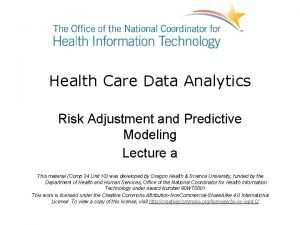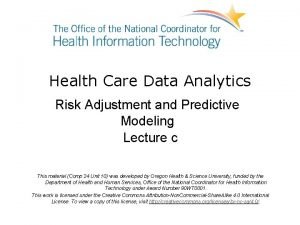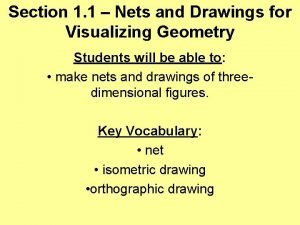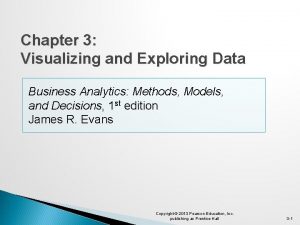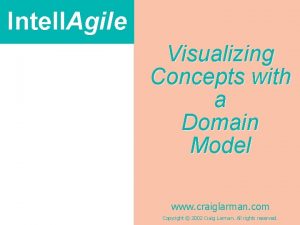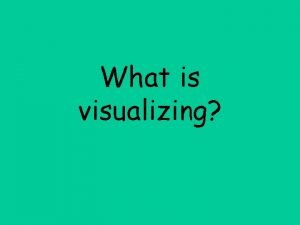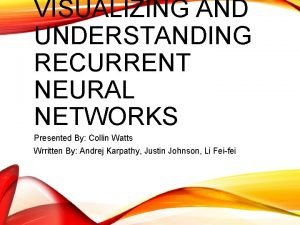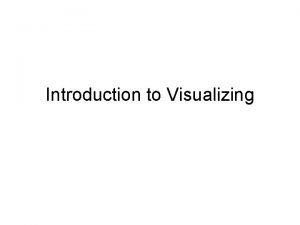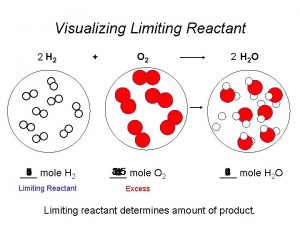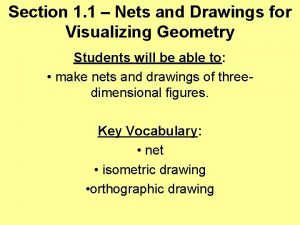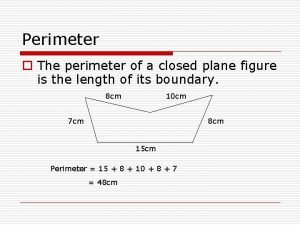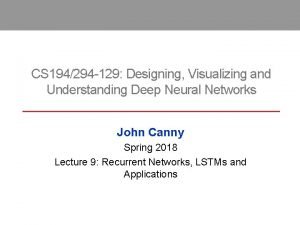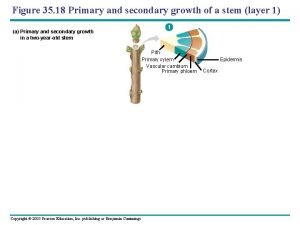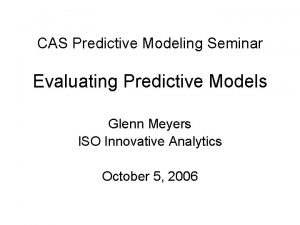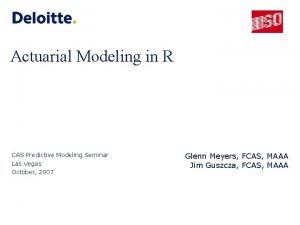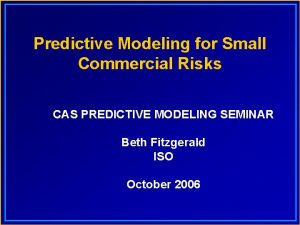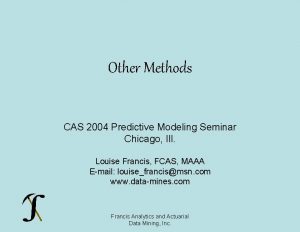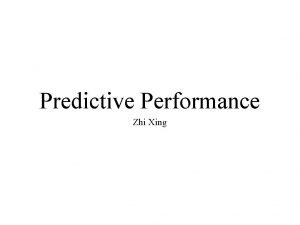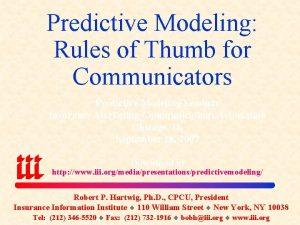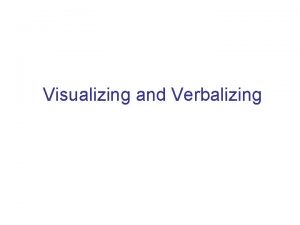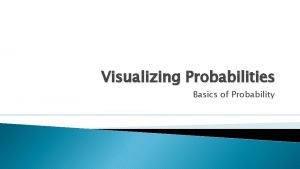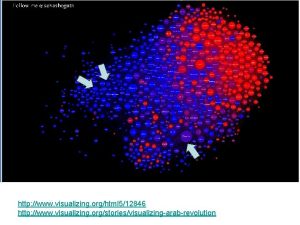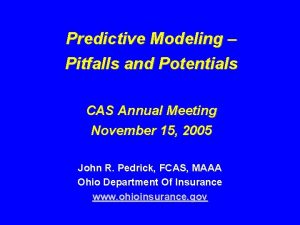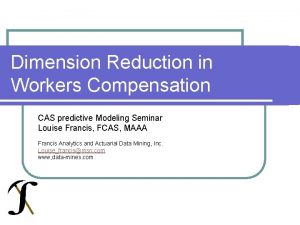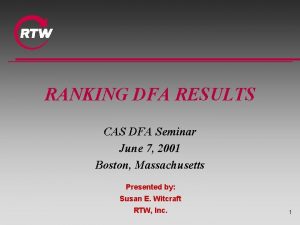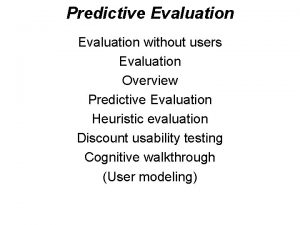CAS Predictive Modeling Seminar Visualizing Predictive Modeling Results































- Slides: 31

!@ CAS Predictive Modeling Seminar Visualizing Predictive Modeling Results Chuck Boucek (312) 879 -3859 #

Agenda • Data Validation • Hypothesis Building • Model Testing • Monitoring • Visualization as a Diagnostic Tool 1

Data Validation • Goals – Validate reasonableness of data – Understand key patterns in data – Understand changes in data and underlying business through time 2

Data Validation • Histogram is a simple tool to for reasonability testing of modeling database 3

Data Validation • Mosaic Plot shows the distribution of predictors in two dimensions 4

Data Validation • Missing Data plot shows the relationship of missing data elements 5

Data Validation 0. 0 0. 1 0. 2 0. 3 0. 4 0. 5 0. 6 0. 7 0. 8 0. 9 1. 0 Claims Match to Exposure • Time series plots identify consistency of data over time Company 1 Company 2 Company 3 1994 1995 1996 1997 1998 1999 2000 2001 2002 2003 2004 6

Hypothesis Building • Goals – Perform initial analysis of potential predictor variables – Limit the list of predictor variables to be employed in subsequent phases of model building – Further reasonability testing of data 7

0 0. 001 0. 02 0. 3 0 0. 02 200 0. 01 0 0. 001 Premium ($MM) 50 100 150 0 0 10000 0. 3 Exposure ($MM) 2500 5000 7500 0. 02 0 0. 01 40000 0. 001 32500 0. 001 25000 Severity 0 17500 0 10000 0. 250 0. 0 5000 0. 375 0. 500 Loss Ratio 0. 750 Frequency 10000 0. 625 1. 12500 Pure Premium 7500 0. 750 1. 500 15000 Demographic Variable 1 8

Hypothesis Building • Quantile-Quantile plots help identify needed transformations of data 9

Hypothesis Building • Correlation Web concisely summarizes a correlation matrix 10

Model Building • Model building is an iterative process • Understanding patterns and relationships throughout this process is critical 11

Model Building • Partial Plots are a key tool to visualize predictor variables throughout the model building process • What is a “Partial Plot? ” Linear Predictor = k + b 1 X 1 + b 2 X 2 + b 3 X 3 + b 4 X 4 Predicted value = (ek) x (eb 1 X 1) x (eb 2 X 2) x (eb 3 X 3) x (eb 4 X 4) • Partial Plot demonstrates an individual predictor variables contribution to final prediction 12

Model Building • Partial Plot demonstrates an individual predictor variables contribution to final prediction 8000 1. 25 4000 6000 1. 00 2000 0. 75 0 0. 50 0 5 10 15 20 25 30 13

Model Building 0. 25 0. 50 0. 75 1. 000 1. 25 • Partial Plot with modified scatter plot of variable 0 10 20 30 14

Model Building • Time Consistency plot is a critical tool for numeric predictors 0 0 5 10 15 1997 1998 1999 2000 15 20 20 25 25 15

Model Building • Partial Plot for a factor variable 1. 30 1. 20 Credit Level 2 1. 10 1. 00 0. 80 0. 70 Credit Level 1 0. 90 16

No Yes 200 No 0 Yes Premium ($MM) 50 100 150 No No 0 Exposure (Pred. Count) 2500 5000 7500 10000 40000 Yes 32500 Yes 25000 No 17500 No 10000 Severity 0. 250 0. 0 5000 0. 375 7500 0. 500 Loss Ratio 0. 750 Frequency 10000 0. 625 1. 12500 Pure Premium 0. 750 1. 500 15000 Credit Variable 1 17

Model Testing • Likely the most critical visualizations in predictive modeling work – Management’s perception of a project’s success will likely depend on these visualizations • Holdout tests • Cross validation tests 18

Model Testing • Lift Chart shows overall model performance Loss Ratio Lift Chart - Holdout Sample 1. 0 Predicted Actual 0. 9 0. 7 0. 8 0. 7 0. 6 0. 5 0. 4 19

Model Testing • ROC Curve shows overall model performance 0. 4 0. 6 0. 8 1. 0 Holdout Sample ROC Curve 0. 0 0. 2 Null, 0 Perfect, 1 prem, 0. 51 pred. loss, 0. 56 0. 0 0. 2 0. 4 0. 6 0. 8 1. 0 20

Model Testing • Classical Cross Validation exhibit Prediction Error Out of Sample Error Number of variables in final model In Sample Error 5 10 15 20 25 Number of Predictors 21

Monitoring Model Results • The work does not end when the lift chart looks good • Monitoring tools – Decile management – Exception analysis – Model vs. Actual Results 22

Monitoring Model Results • Decile Management – – Retention Loss Ratio Rate Action Tier/Schedule Mod 23

Monitoring Model Results • Average score over time 24

Monitoring Model Results • Loss ratio of model exceptions 25

Visualization as Diagnostic Tool • Frequency and severity models have been developed • Model is underperforming in predicting loss ratio • Likely cause of underperformance is severity model 26

Visualization as Diagnostic Tool 27

Visualization as Diagnostic Tool 28

Visualization as Diagnostic Tool 29

Visualization as Diagnostic Tool • Two different visualizations of the same model tell a very different story! 30
 Predictive maintenance seminar
Predictive maintenance seminar Aep predictive modeling
Aep predictive modeling Predictive risk modeling
Predictive risk modeling Health care risk adjustment and predictive modeling
Health care risk adjustment and predictive modeling Predictive analytics risk adjustment healthcare examples
Predictive analytics risk adjustment healthcare examples Model and role modeling theory
Model and role modeling theory Relational vs dimensional data modeling
Relational vs dimensional data modeling 1-1 practice nets and drawings for visualizing geometry
1-1 practice nets and drawings for visualizing geometry Performance lawn equipment case study
Performance lawn equipment case study Domain model guidelines
Domain model guidelines Visualizing environmental science (doc or html) file
Visualizing environmental science (doc or html) file Visualizing reading strategy
Visualizing reading strategy Nets and drawings for visualizing geometry
Nets and drawings for visualizing geometry Visualizing and understanding recurrent networks
Visualizing and understanding recurrent networks Visualizing and verbalizing program
Visualizing and verbalizing program Organizing and visualizing variables
Organizing and visualizing variables Visualizing and verbalizing activities
Visualizing and verbalizing activities Visualizing magnetic field
Visualizing magnetic field Limiting reactant
Limiting reactant Organizing and visualizing variables
Organizing and visualizing variables Nets and drawings for visualizing geometry
Nets and drawings for visualizing geometry Visualizing and understanding convolutional neural networks
Visualizing and understanding convolutional neural networks The perimeter of a closed plane figure is the length of its
The perimeter of a closed plane figure is the length of its Visualizing environmental science solution manual
Visualizing environmental science solution manual Visualizing and understanding neural machine translation
Visualizing and understanding neural machine translation Shield volcano
Shield volcano Electric currents and magnetic fields
Electric currents and magnetic fields Shoko hamano
Shoko hamano Net of a cube
Net of a cube Coco
Coco Visualizing primary and secondary growth
Visualizing primary and secondary growth Visualizing environmental science solution manual
Visualizing environmental science solution manual



